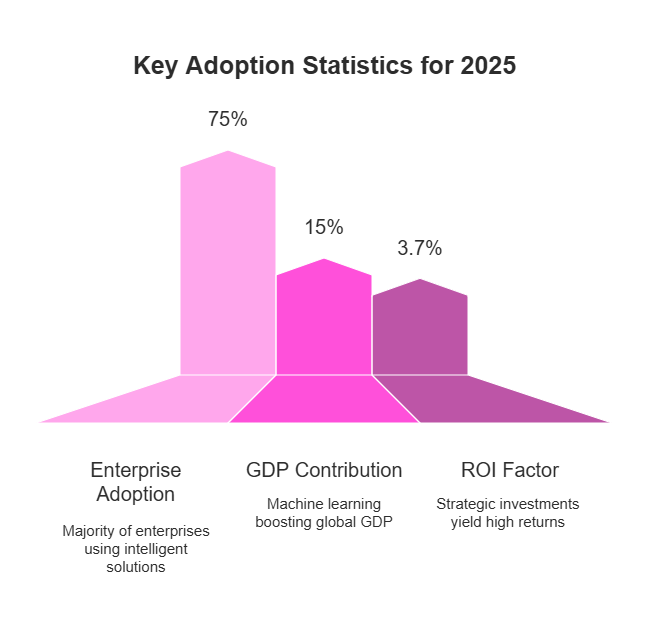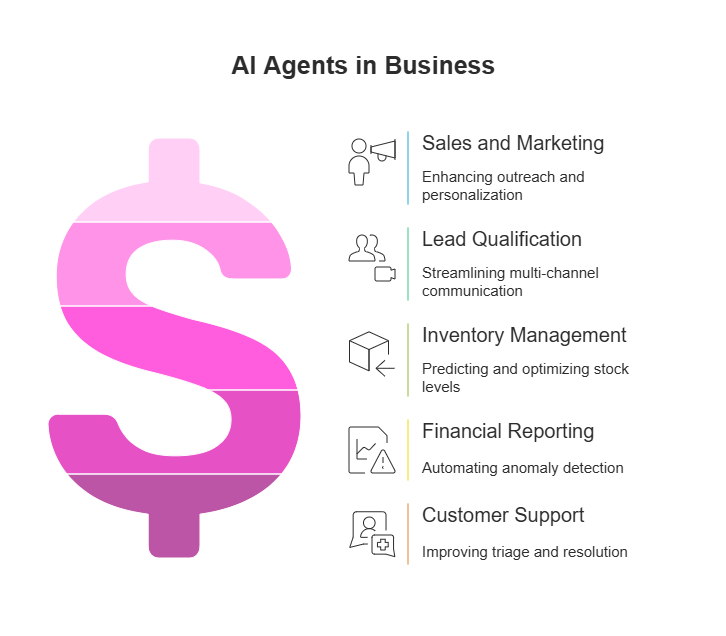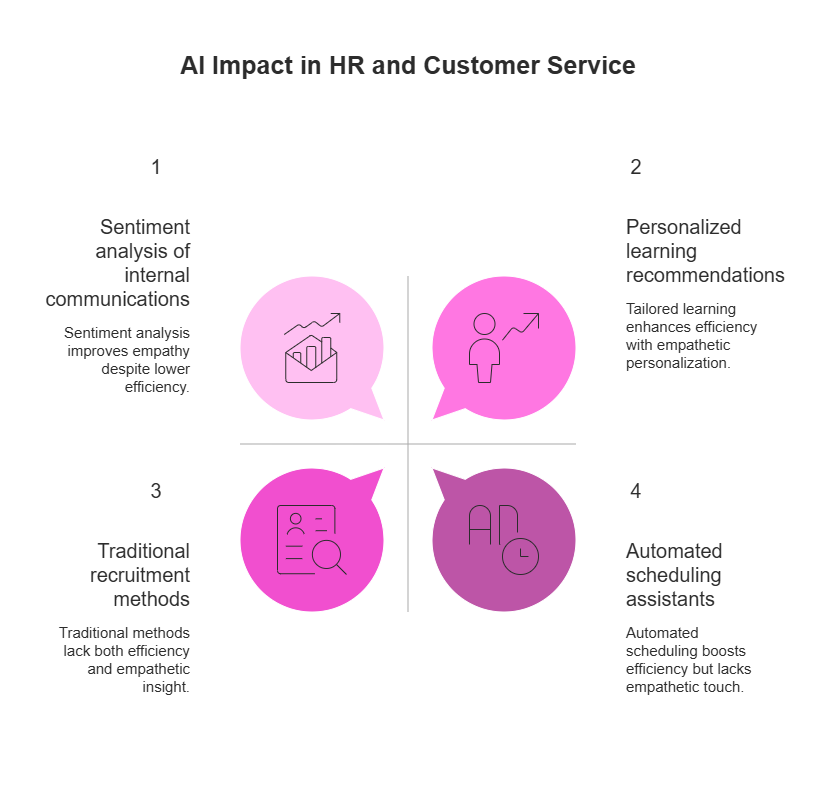This article explores the major artificial intelligence trends reshaping business in 2025. We examine how AI has evolved from experimental projects into core business functions across organizations of all sizes. Companies now deploy these technologies to achieve measurable results rather than just testing capabilities. The landscape continues changing rapidly, with new developments making AI more accessible, efficient, and valuable for specific business applications.
By the end of this article, you’ll understand the practical applications of these technologies and how to implement them effectively in your business. Too often, companies struggle with adoption despite clear benefits. Our guidance will help you develop a strategic approach to AI implementation that delivers measurable value.
The Transformative AI Landscape of 2025: What Business Leaders Need to Know
Artificial intelligence has rapidly evolved from experimental labs into corporate boardrooms, becoming a strategic imperative for organizations across industries. According to a recent global AI spending forecast, investments will surge beyond $500 billion by the end of 2025, signaling unprecedented adoption at scale. This massive financial commitment reflects how AI has shifted from a technological curiosity to a fundamental business asset.
Business leaders recognize this seismic shift. A comprehensive McKinsey AI investment survey reveals that 56% of executives are accelerating their AI investments specifically to gain competitive advantages. For companies navigating this landscape, understanding emerging AI trends becomes crucial for strategic planning and market positioning.
The democratization of AI through no-code platforms represents perhaps the most significant development. These accessible systems allow professionals without technical backgrounds to harness sophisticated AI capabilities. Cubeo AI stands at the forefront of this movement, enabling organizations to implement powerful AI solutions without extensive coding expertise. As we explore the key trends shaping 2025, the focus remains on practical applications that drive measurable business outcomes.
The Evolving AI Landscape in 2025
Artificial intelligence has matured dramatically. It now moves beyond isolated experiments into core business functions. Companies deploy AI solutions across operations instead of limiting them to pilot projects. This shift stems from two primary factors: unprecedented data availability and growing computing power.
Organizations seeking advantages must navigate this changing landscape. Cubeo AI simplifies this journey by providing accessible tools. These solutions democratize implementation for businesses of all sizes. Our platform allows companies to optimize content for both search engines and AI platforms. This approach mirrors how enterprises must adapt operational strategies for an AI-enhanced future.
The Shift to Mainstream AI Use
Enterprise implementation has crossed a critical threshold. Companies now move beyond experimental proofs of concept. They focus on full-scale deployment across departments. According to recent research by MoneyPenny, 34.18% of U.S. businesses actively use artificial intelligence. Another 34.27% seriously consider adoption in the near term.
Content creation leads application areas at 39.33%. Customer service and analytics follow closely behind.
Key Adoption Statistics for 2025
The numbers tell a compelling story about accelerating momentum:
- 75% of enterprises will employ intelligent solutions by the end of 2025, as projected by Coherent Solutions
- Machine learning technologies are expected to contribute a 15% boost to global GDP
- Organizations investing strategically report a 3.7x return on investment
- Implementation rates vary significantly by sector
These statistics reflect a fundamental shift in how businesses view computational intelligence. It’s no longer experimental technology but essential infrastructure.
Healthcare organizations leverage these systems for diagnostic support and patient management. Financial institutions deploy automated analysis for risk assessment and fraud detection. Manufacturing companies show slower adoption curves but, in fact, achieve higher ROI when implementation succeeds.

The Rise of Autonomous AI Agents
Autonomous AI agents go far beyond basic generative models in capability. Generative AI simply creates content when prompted. Agents, however, perform tasks, make decisions, and learn from outcomes with minimal supervision. These systems monitor environments, analyze data, and execute workflows on their own. According to recent research, the market for such technologies now stands between $7.92 billion and $9.9 billion in 2025, with projections reaching $236.03 billion by 2034.
The ability to handle complete processes makes these agents truly transformative for businesses.
From Generative Models to Autonomous Assistants
Agentic AI builds upon generative foundations while adding crucial new capabilities. Memory, planning, and goal-oriented behavior set these systems apart. Standard generative AI produces isolated outputs. Agents, in contrast, maintain context across interactions and improve through continuous learning. They adapt to changing conditions and refine their approaches based on feedback.
Think about the difference in value between these approaches. A generative model might write a single email. An agent could manage your entire correspondence workflow, identifying priorities, drafting responses, and tracking outcomes. This evolution delivers greater value by handling complete processes rather than just individual tasks.
Business Applications of AI Agents
Early adoption of autonomous agents has been particularly strong in sales and marketing teams. The LinkedIn DM Generator from Cubeo AI shows this capability in action. Sales teams can generate personalized outreach messages from profile URLs in minutes instead of hours. Such tools demonstrate how agentic systems scale effectively for business needs.
AI agents excel across numerous business functions beyond just outreach:
- Lead qualification through multi-channel communication
- Inventory management with predictive restocking
- Financial reporting with automatic anomaly detection
- Customer support triage and resolution
Recent studies show that 79% of business leaders now view AI as critical for competitiveness. One consumer goods company used an AI marketing agent to compress a week’s work into just one hour, a 97% efficiency gain. Such dramatic improvements help explain why adoption continues to accelerate across industries.

Multimodal AI Breaking Down Data Silos
Traditional AI systems often operate in isolation. They process either text, images, audio, or video, but rarely all together. Multimodal AI changes this paradigm by analyzing multiple data types simultaneously. This approach creates a unified understanding similar to human perception. In fact, this rapidly growing sector was valued at $1.6 billion in 2024. It shows remarkable momentum with a projected compound annual growth rate of 32.7% through 2034, according to Global Market Insights.
Businesses now recognize the value of connecting previously siloed information.
Gartner’s research supports this trend. They predict that 40% of generative AI solutions will be multimodal by 2027, a dramatic increase from just 1% in 2023. This shift will transform how organizations extract insights from diverse data assets. Too often, valuable connections between different information types remain undiscovered without cross-modal analysis.
The Power of Cross-Modal Understanding
When AI engines combine multiple data types, they create richer insights impossible through single-modal analysis. Consider a customer service interaction where text analysis might miss sarcasm. Voice tone makes this obvious to human agents. By processing both elements together, these platforms capture nuance that would otherwise disappear.
Advanced models like GPT-4 and Google’s Gemini demonstrate this capability extremely well. They understand relationships between images and text seamlessly. The challenge lies in aligning diverse data streams correctly. Teams must ensure temporal and contextual relationships remain intact across all modalities.
This approach mirrors how people naturally process information in everyday situations. Just as we integrate what we see and hear, multimodal AI creates more intuitive responses. This capability leads to more accurate AI performance in complex scenarios.
Real-World Multimodal Use Cases
Healthcare organizations lead in adopting these integrated technologies. They combine medical imaging with patient records and verbal descriptions. One hospital system reported a 28% improvement in early detection rates after implementing multimodal AI use cases for radiology reviews, as highlighted by SmartDev.
Retail companies leverage these capabilities through several applications:
- Virtual shopping assistants processing visual searches alongside text queries
- Quality control systems analyzing production footage with sensor data
- Customer experience platforms integrating call recordings with chat histories
Financial institutions employ these cross-modal solutions for fraud detection. They simultaneously analyze transaction patterns, voice verification, and security footage. This creates layered security impossible with traditional single-channel approaches.
The foundation for these advanced capabilities often relies on retrieval-augmented generation. RAG enhances AI outputs by grounding them in verified external data sources. This technology reduces hallucinations while ensuring multimodal engines maintain accuracy across diverse information streams.
LLMs Evolution into Leaner Models
Smaller now beats bigger in language model development. A significant shift toward compact, specialized LLMs actually marks 2025 as the year of efficient AI. Early models demanded massive computational resources for operation.
Newer architectures, in some respects, deliver superior performance with just a fraction of the footprint. This evolution addresses three critical business needs: speed, cost-effectiveness, and environmental sustainability.
Research from Nature confirms these efficiency advantages. A comparative life cycle assessment demonstrates that LLMs significantly reduce energy consumption compared to equivalent human labor. Human-to-LLM efficiency ratios range from 40 to 150 for typical applications, which is pretty remarkable when you think about it.
The Efficiency Revolution in Language Models
Technical improvements driving this efficiency revolution show impressive results. Advanced compression techniques have, in a way, slashed inference costs by up to 65% while maintaining quality. Response times have improved dramatically, specialized models deliver answers in milliseconds rather than seconds.
Carbon-aware frameworks like EmbAdvisor optimize cache sizes for LLM serving, too. These frameworks reduce emissions by up to 31.2%, making AI deployment more sustainable for organizations of all sizes.
The GPT-4o model exemplifies this trend toward resource-efficient AI. It delivers enhanced performance per cost unit while supporting multimodal inputs. Such advancements enable businesses to deploy sophisticated AI capabilities without needing prohibitive infrastructure investments.
Specialized LLMs for Business Tasks
Industry-specific systems now tackle specialized business challenges with unprecedented precision. You know, it’s almost like having custom tools for every job:
- Sales enablement LLMs analyze prospect communications and suggest personalized outreach strategies
- Legal assistants trained on case law and regulatory documents draft compliant contracts in minutes
- Financial systems detect fraud patterns while explaining their reasoning in auditable formats
- Healthcare solutions summarize patient records while maintaining strict HIPAA compliance
Customization extends beyond industry focus, as a matter of fact. Organizations increasingly fine-tune domain-specific LLMs on proprietary data, creating unique competitive advantages.
This specialization trend continues accelerating as training tools become more accessible. Businesses no longer face choosing between powerful AI and reasonable costs, today’s leaner architectures deliver both. According to recent research, these efficient approaches support sustainability goals through significantly reduced energy consumption compared to traditional methods.
AI Democratization with No-Code Platforms
The most exciting trend of 2025 isn’t the technology itself. It’s actually about who can use it. Visual AI platforms remove coding barriers, allowing professionals from any field to create sophisticated solutions without programming knowledge. This shift addresses a growing market gap. While AI expertise demand rises, qualified developers remain in short supply.
The economic story tells it all. According to BrainForge.ai, the global visual AI platform market will grow from $3.83 billion in 2023 to nearly $38 billion by 2033, representing a 29.6% annual growth rate.
Success with these platforms follows a structured approach. Cubeo AI offers a seven-step process from concept to reality guiding users through purpose definition, data gathering, model selection, and deployment. This methodology helps organizations achieve their goals, as 64% of businesses expect AI to boost efficiency but often struggle with implementation steps.
Breaking Down Technical Barriers
Modern visual platforms use intuitive interfaces where users connect components through simple drag-and-drop actions. These systems hide complexity while maintaining powerful functionality. A recent IBM survey found that, in a way, 75% of respondents had already used AI-driven tools, showing widespread appetite for accessible solutions.
What makes these tools revolutionary? They eliminate the traditional bottleneck of specialized knowledge. Marketing teams can build customer models, HR departments can create screening tools, and operations managers can develop maintenance systems, all without waiting for technical resources.
The speed boost proves equally impressive. Projects that once took months now launch in days, allowing rapid testing and refinement.
The Business Case for No-Code AI
ROI appears within weeks rather than the months typical of traditional AI projects. Too often, companies hesitate due to cost concerns.
Cost advantages extend beyond initial development. Updates require fewer specialized resources, and the platforms continuously improve with new capabilities. This sustainability makes codeless AI particularly attractive for mid-market organizations with limited technical talent.
Interestingly, according to IBM, 42% of enterprise-level organizations actively use AI systems, while smaller businesses lag behind. Visual platforms bridge this gap by enabling broader participation. When domain experts directly shape solutions, the resulting tools better address real operational needs and gain faster acceptance among users.
AI Governance and Ethical Practices
Ethical considerations now form core requirements for sustainable AI implementation. As capabilities expand, governance frameworks must evolve too. Recent studies show organizations adopting responsible AI practices gain competitive advantages in their markets.
The stakes keep rising as systems become embedded in critical operations. Navigating trade-offs between innovation and responsibility presents ongoing challenges for teams. Research indicates the need for adaptive governance methods to manage AI-related risks effectively. These approaches ensure technologies promote both individual and societal wellbeing.
AI governance requires balancing technical capabilities with human values. Organizations implementing structured oversight see fewer ethical incidents. This balance supports long-term adoption while minimizing potential harms.
Building Trust Through Transparent AI
Transparency serves as the foundation for ethical AI deployment. Users deserve clarity about how systems reach conclusions that affect their lives. Technical solutions like explainable methods help address this need.
Effective transparency requires several key practices. Regular model audits by independent reviewers verify performance claims. Human oversight for high-stakes decisions prevents automated errors. Clear documentation of data sources builds credibility with stakeholders.
These approaches, in a way, address common concerns about AI tools. While systems accelerate tasks and reduce many errors, organizations must acknowledge both benefits and limitations honestly. Transparency builds authentic relationships with users and regulators alike.
Regulatory Trends Shaping AI Use
The regulatory landscape for AI evolves rapidly across jurisdictions. New frameworks emerge as technologies advance into sensitive domains. The Consumer Protections for Artificial Intelligence Act represents just one significant development in governance approaches.
Industry-specific regulations create additional complexity for teams. Healthcare organizations ensure systems comply with HIPAA requirements. Financial institutions navigate SEC and FINRA guidelines alongside general AI regulations. Federal mandates increasingly focus on bias mitigation and human oversight.
Established frameworks like GDPR in Europe and CCPA in California already impose substantial requirements. These rules affect data usage and algorithmic decision-making across borders. Organizations operating globally must reconcile sometimes conflicting standards.
Cubeo AI addresses these challenges through built-in compliance tools. These features include audit trails for model decisions and data governance controls. Customizable review workflows maintain human judgment in critical processes. This balanced approach ensures systems remain both powerful and responsible while meeting regulatory expectations.
Industry-Specific AI Transformations
Each industry adopts AI differently, tailoring applications to address unique challenges and opportunities. The impact varies dramatically across functions. Sales teams leverage AI for prospect identification and personalized outreach. In marketing departments, these tools optimize campaigns and generate content.
HR professionals use similar technology to streamline recruitment processes. What unites these diverse applications? Well, a focus on ethical deployment and sustainable implementation practices remains essential.
Research indicates that 79% of business leaders now consider AI indispensable for maintaining competitiveness. However, Deloitte reports that 53% of organizations face unexpected costs during implementation.
This gap highlights the importance of strategic planning when deploying AI solutions across different business functions.
Reinventing Sales and Marketing
Sales organizations achieve remarkable results through AI-powered processes. According to AI case studies, Amazon’s recommendation engine accounts for 35% of their total sales, demonstrating the revenue potential of intelligent algorithms.
These systems analyze customer behavior patterns to deliver personalized suggestions at just the right moment.
For B2B organizations, AI transforms prospecting efforts. Ten practical applications range from automated lead scoring to personalized pitch creation.
Sales teams using these tools report 27% higher close rates and 41% faster deal cycles.
Marketing departments benefit similarly from AI-driven campaign optimization. These systems continuously analyze performance data, adjusting targeting parameters to maximize conversion rates.
Smart HR and Customer Service
Human resources departments embrace AI to transform talent acquisition. The global AI in HR market reached $3.25 billion in 2023 and continues expanding at a 24.8% compound annual growth rate.
Organizations implementing these technologies report a 30% decrease in recruitment costs.
LinkedIn’s AI-powered recruitment tools cut hiring time in half while identifying 42% more qualified candidates. These systems analyze resumes more effectively than traditional methods.
Beyond recruitment, AI enhances employee experiences through:
- Personalized learning recommendations based on career goals
- Sentiment analysis of internal communications to identify engagement issues
- Automated scheduling assistants that optimize meeting times
- Intelligent knowledge bases that answer employee questions instantly
Customer service operations benefit similarly from AI implementation. Intelligent routing systems direct inquiries to appropriate specialists.
Sentiment analysis helps representatives understand emotional context. These technologies balance efficiency with empathy, reducing resolution times while maintaining human connection.

Seamless AI Integration with Workflows
Standalone AI tools offer minimal value on their own. Business transformation occurs when AI capabilities blend into existing processes. Flexible APIs enable modern integration approaches. Webhooks trigger actions based on specific events. Purpose-built connectors link popular platforms seamlessly. These technical bridges allow AI to enhance established workflows rather than disrupt them. Organizations now adopt unified dashboards that basically combine insights from multiple AI systems.
Agentic RAG systems represent a powerful integration pattern in today’s landscape. They pair retrieval-augmented generation with autonomous decision components. This combination reduces hallucinations significantly. Complex reasoning becomes more reliable. AI systems can access information and actively drive business processes forward.
Creating Cohesive AI-Enhanced Workflows
Effective integration starts with thoughtful process design. Map your current workflows first. Next, identify decision points where AI adds value. Then implement connectors maintaining data flow between systems. This approach sort of preserves institutional knowledge while boosting capabilities.
The Power of Retrieval-Augmented Generation shines in these integrated workflows. Organizations pair language models with real-time data retrieval. This ensures AI responses stay accurate and contextually relevant. An e-commerce implementation recently reduced customer service resolution times by 47%. They connected their inventory system with a RAG-powered chatbot.
Cross-functional teams gain the most from cohesive workflows. Marketing creates content automatically. Sales personalizes it for prospects. Customer service insights drive product development priorities. Each team keeps their specialized tools while AI facilitates handoffs between departments.
The Role of APIs in AI Ecosystems
APIs function as the nervous system for AI ecosystems. REST APIs provide standardized access to capabilities. GraphQL offers more flexible data retrieval patterns. Developers can incorporate AI functions into existing applications without rebuilding core systems.
Event-based automation flows rely on webhook-driven architectures. A customer submits a support ticket. Webhooks trigger AI analysis to determine priority. The system routes issues to appropriate teams. It suggests responses based on similar past cases. Manual handoffs decrease while process integrity remains intact.
CRM integrations highlight these principles in real-world scenarios. Companies implementing AI agents within customer platforms report impressive results. Recent research shows these integrations cut response times by up to 35%. Customer satisfaction rates increase by 28% as well. These metrics demonstrate the tangible value of connected systems.
Security remains essential in connected environments. OAuth authentication protects access points. API keys with granular permissions limit exposure. Encrypted data transmission safeguards sensitive information. Comprehensive audit logs track AI actions across workflows. This accountability enables continuous improvement through performance analysis.
Measuring AI ROI and Impact
Quantifying AI’s business impact remains challenging yet essential for sustained investment. Many organizations struggle to move beyond vague notions of “innovation” toward concrete financial metrics.
Research reveals encouraging financial returns, actually. Businesses typically see $3.50 back for every dollar invested in generative AI. Top performers achieve up to $8 in return. These results depend heavily on implementation quality and strategic alignment. Organizations with mature AI practices consistently outperform those treating AI as experimental technology.
The maturity factor proves significant in some respects. According to LXT’s analysis, 48% of organizations report high AI maturity levels with demonstrable ROI. These companies share common practices: clear baseline measurements before implementation, regular performance reviews, and strategy adjustments based on results.
Essential AI Performance Metrics
Effective measurement begins with technical metrics that verify system performance. Accuracy benchmarks establish prediction reliability. Latency measurements ensure real-time viability. Throughput capacity determines scalability under load, all critical for operational success.
Beyond technical indicators, user-centered metrics reveal practical value, too:
- Adoption rates across departments
- Time saved per employee
- Error reduction percentages
- User satisfaction scores
The most sophisticated organizations connect these operational indicators to business outcomes. Customer retention improvements and sales cycle shortening directly impact financial statements. Quality training data proves particularly influential, organizations investing in high-quality datasets report higher project success rates.
Turning Insights into Revenue
Cost reduction represents the most straightforward AI ROI path, in a way. Customer service automation typically reduces support costs by 15-30% while maintaining satisfaction. Document processing systems cut manual review time by up to 80%. These efficiency gains translate directly to bottom-line improvements.
Revenue generation offers even greater potential, frankly. Recommendation engines drive substantial upsell opportunities. Amazon attributes 35% of their sales to AI-powered suggestions. Predictive lead scoring helps sales teams prioritize prospects with highest conversion potential.
Forward-looking organizations develop attribution models that track AI’s revenue impact across customer journeys. These frameworks connect AI-driven interactions through final purchase decisions. The most sophisticated companies build forecasting models that predict future revenue streams based on current performance indicators, enabling proactive investment decisions.
Preparing Your Business for the AI-Driven Future
Success with artificial intelligence requires more than technology, it demands organizational readiness. The pace of adoption continues accelerating. Bain’s recent survey reveals that 95% of US companies are now using generative AI, with production use cases doubling year-over-year. This widespread implementation creates both opportunity and urgency for organizations developing their AI strategy.
Many businesses struggle with implementation challenges despite rapid uptake. Cross-functional teams prove essential for bridging technical capabilities with business needs. These collaborative groups combine domain expertise, technical knowledge, and change management skills.
Sustainable AI adoption delivers measurable value when built on a foundation of organizational alignment. Companies that develop clear AI roadmaps often see faster returns on their technology investments. In a way, the planning process itself creates valuable insights about operational inefficiencies and market opportunities.
Strategic Recommendations for Leaders
Executive sponsorship remains the strongest predictor of AI success. Leaders must champion these initiatives while setting realistic expectations about outcomes. Workforce development becomes equally important as technology deployment, nearly 40% of companies anticipate that over 20% of their workforce will need reskilling to work effectively alongside AI systems.
Start with clearly defined use cases addressing specific business challenges. Prioritize opportunities with measurable impact and reasonable implementation complexity. This focused approach builds organizational confidence while developing internal capabilities.
Successful organizations establish governance frameworks balancing innovation with risk management. These structures define roles, responsibilities, and decision rights for AI initiatives. They also create mechanisms for addressing ethical considerations throughout the development lifecycle.
Regulatory compliance requires ongoing attention as AI capabilities evolve. Too often, companies overlook this aspect until late in implementation, creating unnecessary delays and costs.
Building an Adaptive AI Roadmap
Effective AI implementation follows a consistent pattern: pilot, measure, scale. Begin with limited-scope projects demonstrating value while minimizing disruption. Measure outcomes against predetermined success criteria. Scale successful initiatives while applying lessons to future projects.
Consider this phased approach:
- Assessment (Month 1-2): Evaluate organizational readiness and prioritize use cases
- Foundation (Month 3-4): Develop data strategy and establish governance framework
- Pilot (Month 5-6): Implement initial projects with clear success metrics
- Expansion (Month 7-12): Scale successful initiatives and develop internal capabilities
- Transformation (Year 2+): Embed AI throughout business processes and culture
Feedback loops drive continuous improvement throughout this journey. Collect input from users, monitor performance metrics, and regularly reassess priorities. Honestly, organizations that systematically adjust their approach outperform those with rigid implementation plans.
The adaptive approach ensures AI initiatives remain aligned with strategic objectives while incorporating emerging capabilities. With over 80% of AI use cases meeting or exceeding expectations, businesses that maintain flexibility in their roadmaps create sustainable competitive advantage.



